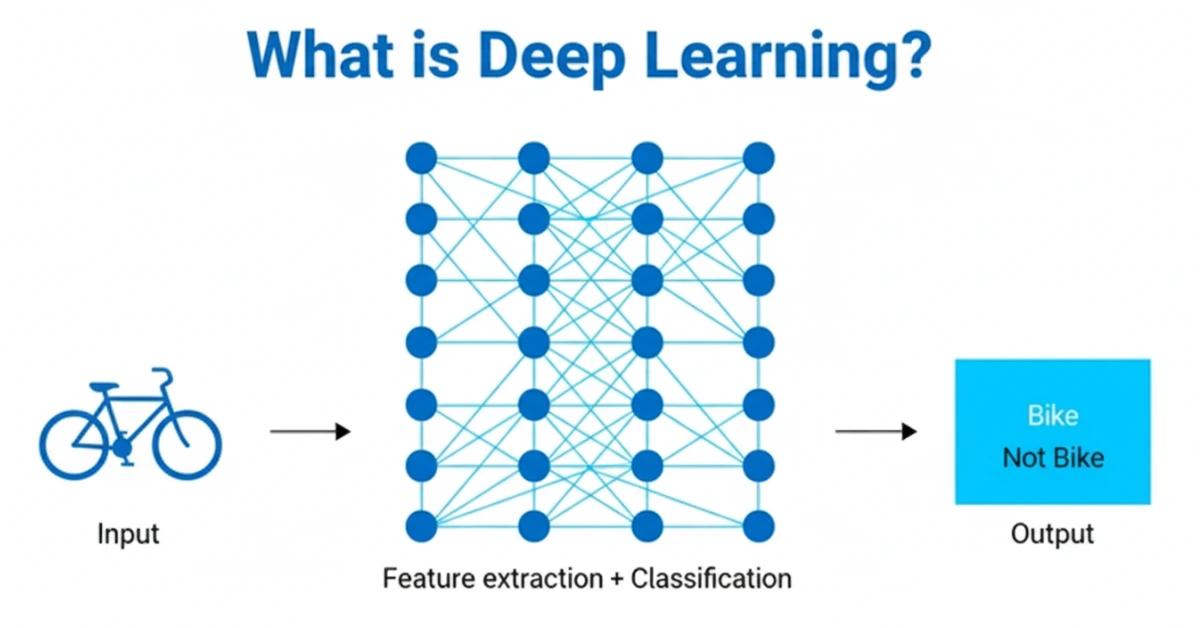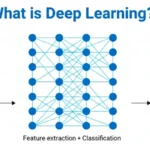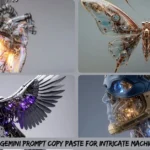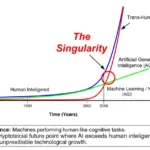Deep learning is used to recognize faces on phones, diagnose diseases, and help assistants hear you. You use it daily without knowing it. Deep learning has transformed fields greatly over just 10 years.
So what is it? Deep learning is a way for computers to learn from data like humans. There are no strict rules – systems find their own from much data. “Deep” refers to many layers of fake brains processing data like your brain does.
What’s special? Deep learning handles tough tasks well – speech, images, and predictions. No programming is needed for every rule. Just show examples, and it learns itself. This guide explains how deep learning works and why it matters to you.
How Does Deep Learning Work?
Deep learning systems adjust thousands of little connections to learn. Like tuning an instrument – each small change improves performance.
It starts with data going into the fake brain’s first layer. Each neuron checks conditions before passing signals forth. The second layer processes signals more deeply. Many layers make up a network, with specialization per layer. Early layers find edges. Middle layers form shapes. Deep layers recognize objects (for faces, cars).
The learning cycle occurs:
- Data goes into the network
- Signals go through layers (forward)
- Network outputs predictions
- Comparison to actual correct answers
- Error measurement done
- Backward flow adjusts weights
- Repeat with different data a thousand times
Repetition causes learning. Each cycle gets better. After millions of examples, this network learns never seen before patterns. There lies true magic—a grasping of general rules rather than just memorization of some instances only.
Why Deep Learning Differs From Traditional Machine Learning
In classic machine learning, people one by one define the features that matter. If it is about dogs, you would code ear shape, tail placement, fur texture, and numerous special characteristics. It could take weeks or months to identify what must be observed.
With deep learning, you give images of dogs, and it automatically discovers. It detects patterns which humans could not think to program. It observes things as critical like eye shape or fur patterns which are better indicators than size.
This can be scaled to problems impossible to solve manually. Recognizing speech from accents and noise? Too many variables to code by hand. Translating languages with idioms and context? No rules could cover it all. Deep learning learns these patterns directly from the data.
They need massive data and computing power. They are like black boxes – hard to explain decisions. Traditional ones are more transparent and efficient with small data, but can’t perform like deep learning in difficult tasks.
Real Applications Changing Your Daily Life
You are already benefiting from deep learning every day. Here are some examples:
Computer Vision recognizes faces, unlocking your phone, identifies products in photos, and reads text in documents. Medical imaging detects tumors faster than doctors.
Natural Language Processing powers search engines understanding questions, filters spam, chatbots learning language, and voice assistants catching your words.
Recommendation Systems predict things to watch, read, or buy based on your taste and prior behavior. Music and social media use them.
Fraud Detection spots unusual transactions, protecting your bank account. Credit cards learn patterns indicating fraud faster than humans could.
Why Deep Learning Still Has Limits
Deep learning can do amazing things, but it is not perfect. It has its limitations, which we should know.
Need Big Data: Deep learning models need huge amounts of data like thousands or millions of examples. With just 50 examples, they usually fail. Basic learning methods can manage small data sets better this presents major difficulties for companies with little data.
High Running Cost: Deep networks require powerful computers to be effective running a big neural network costs money processing millions of requests daily is expensive smaller companies may find traditional methods of AI cheaper.
Black Box: It’s hard to explain why deep learning systems make certain decisions in fields such as healthcare or finance this is a major drawback people need assurance of the reasons behind those choices for trust compliance traditional models are easier to interpret.
Adversarial Attacks: Small modifications made on input samples can confuse deep learning systems, such as Self-Driving Cars, seeing a stop sign as a speed limit sign. These types of attacks remain theoretical but could become possible problems later.
Biases in Data: When your training data reflects human prejudices, so does the resulting model, such as facial recognition, not working well across different skin colors. This is not just technical issues, these are also human issues ingrained within data sets.
Overfitting: Networks sometimes memorize their training data instead of learning the general idea for a new example. A model may score 99% accuracy solely by itself while failing utterly on any other material. This demands regular care.
These limitations don’t imply that deep learning is awful. They merely imply its capabilities, accompanied by certain limitations, much like every other kind of technology! Achieving results relies on being aware of when to utilize it and when you’ll need something alternative.
The Future Of Deep Learning
Deep learning will still develop, albeit not as much as the media keeps saying. We won’t reach artificial general intelligence next year; neither will robots take all jobs by 2030 this has been predicted for many years and still not been realized as yet.
Foreseeable future: Smaller businesses will start using deep learning with more efficient models that require techniques that can explain reasoning better than currently used in terms of small data learning, shift focus from brute-force scales, let alone smarter ways of learning from some datasets.
Most opportunities lie at the intersection between deep learning traditional statistics domain expertise brings together. New AI systems being built by engineers are having knowledge and knowledge about both old new methods picking which tool fits each problem best.
You don’t have to be a deep-learning researcher to gain from these developments; learn the basics for evaluating business AI solutions critically, spotting snake oils, real progress, asking the right questions, and identifying red flags when offering too much assurance.
An era where deep learning becomes an ordinary tool like databases or web services whereby excitement decreases leading to significant transformation because people no longer see common tools does create great changes.










